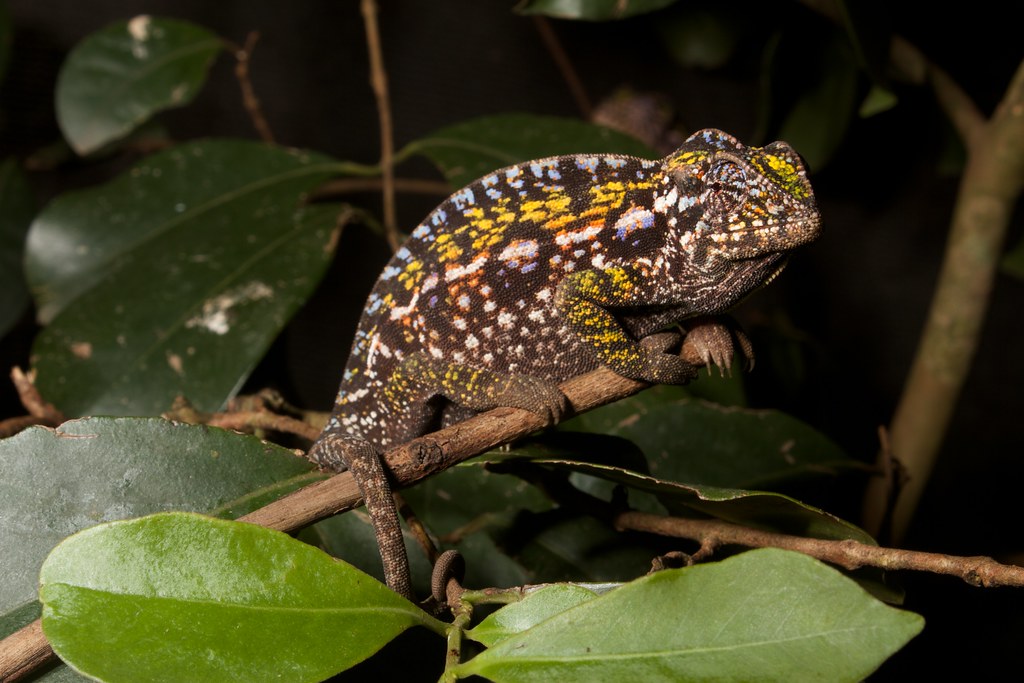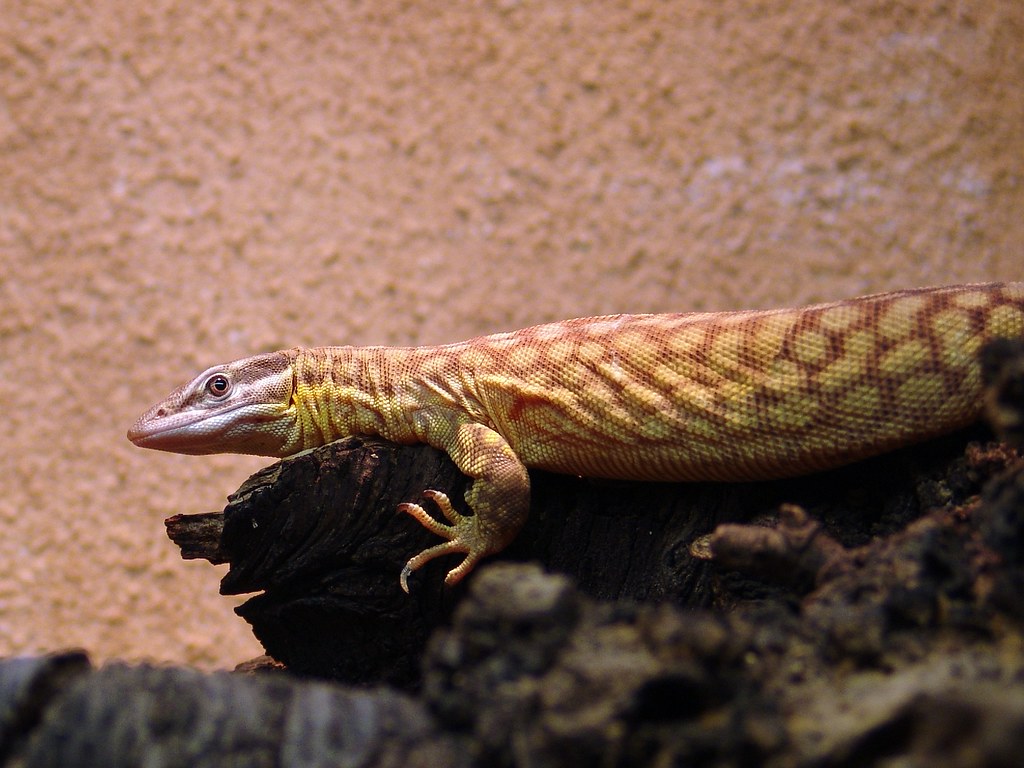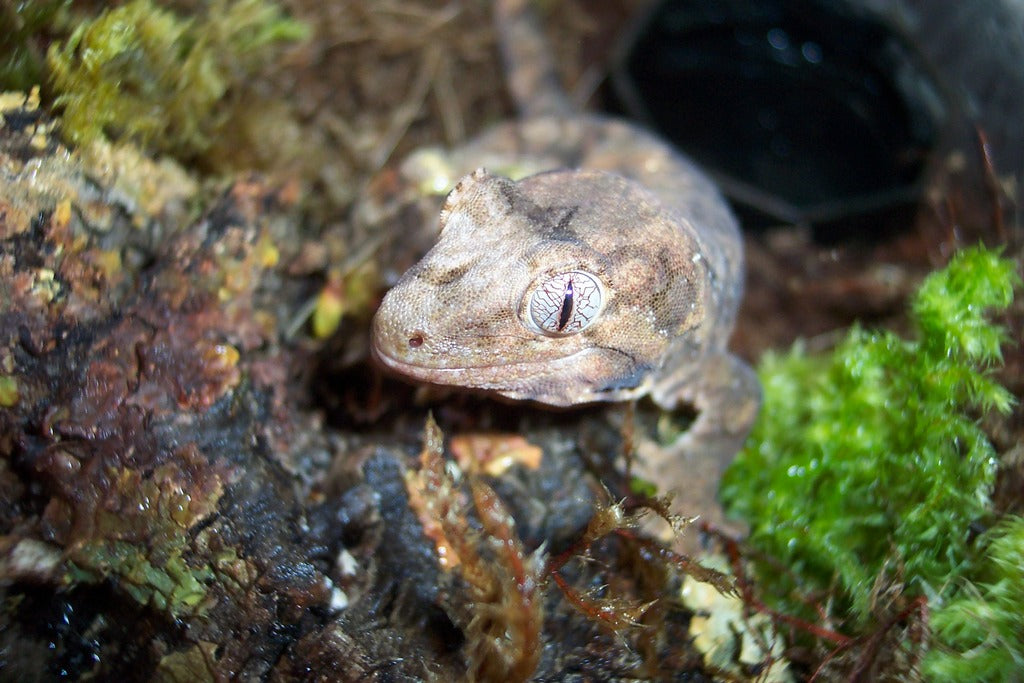Carpet chameleons (Furcifer lateralis) are small, diurnal, arboreal lizards native to Madagascar. They can be found in a wide variety of humid environments around the island, including mountains, deserts, rainforest, and even urban areas. They generally prefer small trees and shrubs with access to both shade and direct sunlight. Carpet chameleons are also known as jeweled chameleons.
Carpet chameleons are 6-10” long, with a typical chameleon appearance that includes a large, triangular head, protruding eyes, vertically-flattened bodies, zygodactylous feet, and a prehensile tail. These are among the most colorful chameleons in the world: males have a green to blue color with yellow or white pattern, while females are patterned in a rainbow of colors. Both sexes’ color and pattern changes depending on mood and environmental conditions.
Captive-bred carpet chameleons are generally considered hardy enough to be beginner-level chameleons. However, as chameleons, they’re still more challenging to keep than your average lizard. With good care, carpet chameleons generally have a lifespan of only 3 years.
How much space do carpet chameleons need?
A single carpet chameleon should be housed in no smaller than a 18”L x 18”W x 24”H enclosure. Of course, larger is better! Despite common claims that they “require” a full-mesh enclosure, it is actually better to use an enclosure with at least 2-3 solid sides, which can be done by covering the sides and back of a mesh enclosure with thin PVC panels. This helps retain humidity and give the chameleon a better sense of security in its enclosure. Glass enclosures have also been proven to work well when properly ventilated.
Cohabitation (keeping multiple chameleons in the same enclosure) is not recommended.
Do carpet chameleons need UVB?
Yes!
UVB lighting is required for carpet chameleons to stay healthy. Aside from helping provide a day/night cycle and providing an infinite supply of vitamin D, UVB is also good for the lizard’s overall health. Here are the best UVB bulbs for carpet chameleons:
- Arcadia T5 HO 6%
- Zoo Med T5 HO Reptisun 5.0
The basking branch should be positioned so the chameleon’s back is 6” below the top of the enclosure. The UVB bulb should be the same length as the enclosure and housed in a reflective T5 HO fixture like the Arcadia ProT5 or Vivarium Electronics. Make sure that the fixture your UVB bulb is housed in does not have a clear plastic bulb cover, as plastic and glass block UVB.
Carpet chameleons are diurnal, which means that they are most active during the day. This means that it’s beneficial to provide an additional daylight-spectrum lamp to make sure the enclosure is brightly illuminated. The Arcadia LED Bar or similar is a good choice for this.
Provide 13 hours of light per day during summer and 11 hours per day during winter to simulate seasonal changes in day length. This helps regulate your chameleon’s hormonal rhythms.
What basking temperatures do carpet chameleons need?
Carpet chameleons need a basking area temperature of 90-95°F and a cool level temperature down to 70-75°F. Nighttime temperatures should drop down to 60-70°F. Temperatures should be measured with digital probe thermometers, with probes placed on the basking spot and the floor on the cool side.
The basking surface itself should be a sturdy wood branch or vine placed near the top per the specifications listed previously.
Provide heat for your chameleon with a halogen heat lamp placed on one side of the enclosure. For best results, elevate the lamp above the top of the enclosure with the Exo Terra Light Bracket. Do not use ceramic heat emitters (CHEs), heat mats, red bulbs, or blue bulbs, as these are not as effective.
Heating should be turned off at night.
What humidity levels do carpet chameleons need?
Carpet chameleons do best with an average humidity of around 70% during the day and higher at night. Mist 2x/day with a pressure sprayer first thing in the morning and in the evening, then run a humidifier on and off over the course of the night. The humidifier should be preferable connected to a humidistat.
Reptile humidifiers and foggers should only be used with distilled water and require frequent disinfecting to keep your reptile from getting sick.
Humidity should be measured with a digital probe hygrometer with the probe in the middle of the terrarium. Humidity levels that are consistently too high or low will make your chameleon sick!
What substrate is good for carpet chameleons?
Because they’re arboreal, carpet chameleons can be kept with or without substrate. If you’re using a glass or hybrid enclosure, soil substrate on top of a drainage layer of clay balls works well. Appropriate soil substrates include Zoo Med ReptiSoil and Zoo Med Eco Earth, although the latter doesn’t work well with live plants. Layer leaf litter on top of the substrate to further help with humidity.
If you’re using a mesh enclosure, you will likely need a drainage system to handle all of the water that it takes such an open style of enclosure to stay humid. This will require some DIY to put together, but it is well worth it in the end.
What décor can you use in a carpet chameleon terrarium?
A bare, minimalistic enclosure leads to a stressed chameleon — and a stressed chameleon is a chameleon that quickly gets sick. In order to create a functional setup for your carpet chameleon, you will need plenty of thin branches, vines, and plants (preferably live). Arrange the foliage to create hiding places for the chameleon to use as needed, with an open area under the heat lamp.
What do carpet chameleons eat?
Carpet chameleons are strictly insectivorous, which means that they need to eat a variety of insects to get the nutrition that they need. How much they need to eat varies depending on age:
- Juveniles — as much as they can eat
- Adults — 5-6 bugs, 2-3x/week
Feeder insect options: crickets, discoid roaches, dubia roaches, banana roaches, red runner roaches, black soldier flies, hornworms, silkworms
Remember, variety is key to great nutrition!
Supplements
You will also need calcium and vitamin supplements to prevent your chameleon from developing a deficiency. Follow this schedule for supplementing a carpet chameleon:
- Every feeding: Repashy Calcium Plus LoD
- Once per month: Repashy Vitamin A Plus
It is also important to make sure that all feeders are well hydrated and gutloaded!
Do carpet chameleons like to be handled?
Truthfully, few reptiles actually “like” to be handled. When it comes to carpet chameleons, they’re generally “hands-off” pets that are better to simply admire than to try to play with. However, if you can build a trusting relationship with your chameleon, they may climb onto your hand when offered.
The key to building a trusting relationship with your pet is to provide as many positive interactions as possible. Offering food from feeding tweezers is a good way to start.
*This care sheet contains only very basic information. Although it’s a good introduction, please do further research with high-quality sources to obtain additional information on caring for this species.
"Furcifer lateralis" by brian.gratwicke is licensed under CC BY 2.0




Leave a comment
This site is protected by hCaptcha and the hCaptcha Privacy Policy and Terms of Service apply.